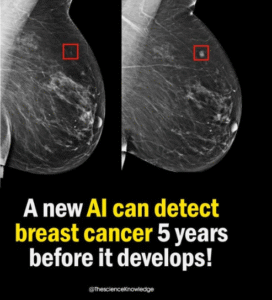A groundbreaking advancement in medical technology has emerged, as researchers have developed a new artificial intelligence (AI) system capable of detecting breast cancer up to five years before it fully develops. This cutting-edge AI uses deep learning algorithms trained on thousands of mammograms and patient data to identify patterns and early warning signs that are invisible to the human eye. By analyzing subtle changes in breast tissue over time, the AI can forecast the likelihood of cancer forming long before a tumor is visible through conventional imaging.
This innovation holds the potential to revolutionize cancer screening and early detection, especially in cases where standard mammography may fail to detect abnormalities. One of the most remarkable aspects of this technology is its ability to recognize precancerous indicators—biological and structural changes that suggest a future malignancy. These insights could allow doctors to monitor high-risk individuals more closely and intervene with preventive measures or treatment before cancer becomes invasive.
The AI model was trained using large datasets containing mammograms from women who later developed breast cancer and those who did not. By comparing these records, the system learned to distinguish between healthy and high-risk tissue patterns. During clinical trials, the AI demonstrated higher accuracy and fewer false positives compared to traditional radiologist reviews. In some cases, it flagged risk indicators as early as five years before a diagnosis would have occurred through standard screening.
This technology could be particularly beneficial in detecting aggressive forms of breast cancer that grow rapidly and are often missed in early stages. Additionally, it may help reduce the anxiety and physical burden of unnecessary biopsies and follow-up procedures, thanks to its improved precision in identifying real risk factors.
Medical professionals and researchers are optimistic about integrating this AI into regular screening protocols. If widely adopted, it could shift the focus from reactive treatment to proactive prevention. Women with a family history of breast cancer or genetic predispositions like BRCA mutations could especially benefit from this early warning system. The AI doesn’t replace doctors but acts as a powerful assistant, enhancing their ability to make timely, informed decisions.
However, challenges remain. Before the AI can be used globally, it needs regulatory approval and further validation across diverse populations. There are also ethical and logistical questions regarding patient privacy, data management, and access to such advanced tools in under-resourced healthcare systems.
Nonetheless, this achievement marks a significant step forward in personalized medicine. By harnessing the power of AI, healthcare providers are better equipped than ever to save lives through early detection, timely intervention, and targeted care. In the future, similar technologies might be applied to other types of cancer and chronic diseases, changing the landscape of healthcare and disease prevention forever.


